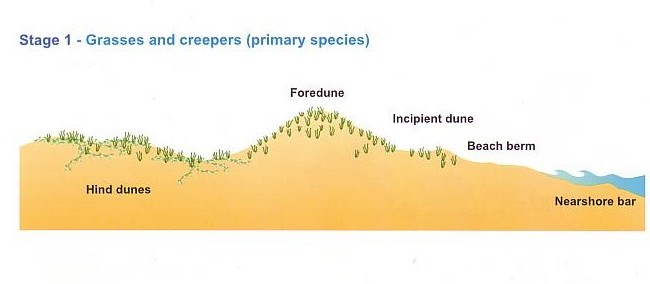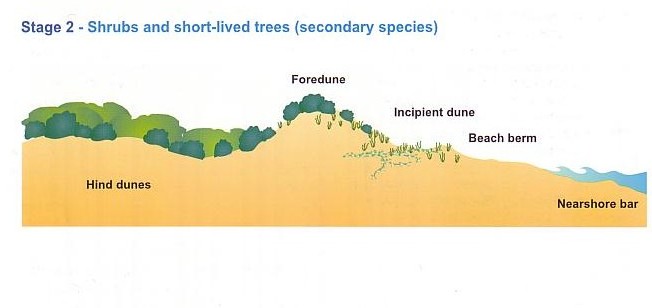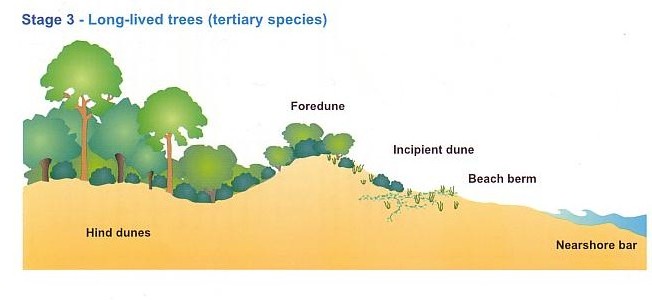
2.4 Biogeographical Processes
- It is obvious that the biosphere is the biotic component of Coastal Sand Dunes.
- The key role that vegetation plays in the accretion cycle is to store and help build up sand.
- Without the vegetation, Coastal Sand Dunes would not have accumulated.
- Two key processes occur with the biopsphere in coastal sand dunes; colonisation and succession.
a) Colonisation and Succession on Coastal Dune Systems
Colonisation= First organisms to inhabit a bare patch of the lithosphere.
Succession= The sequence of organisms that succeed after each other in an ecosystem until it reaches a climax community
Most Dune vegetation has started in the same humble way. A stray piece of floating vegetation is deposited high above the tide line onto the berm or sand ridge by a storm, it might be a straggle of seaweed or parts of a mangrove plant, a small potential nuclei for the seeding of a dune. Trapped by drying sand around them they in turn become catchments for further wind blown sand that eventually creates a tiny mound around it: a mini dune.
The sea weed brings with it passengers that feed on the tiny algae attached to it's surface. Sea birds come together on bare areas like beaches on which they rest from the harsh coastal conditions. These are spots, especially if there are raised areas where they can detect predators easily. They also like to eat small crustaceans.
The little mound now receives bird droppings rich in nutrients such as nitrates and phosphates, good plant food. Inevitably some of these beach "pimples" will stop the wind blowing tumble weeds, which often carry the seeds of resilient grasses called spinifex. Soon after,it germinates to establish a root hold and spreads web like rhizomes (creeping stems) to capture the mound and other rolling tumble weeds in it's first act of sand stabilisation and dune formation. These are the pioneer colonisers of sand dunes and are the primary species in the succession process.
The mini dunes around are joined together by the hopping action of wind blown beach sand (called saltation) birds, debris from storm and those amazing sand holding grasses that are around all year round (perennial) called Spinifex improves local conditions for other binders such as pig face and the goatsfoot vine to join the battle for stabilisation. Together with time, isolation and minimal interference they help create the first thin skin of coastal protection called a primary dune. This primary vegetation is the foundation and gives the stability for other vegetation to build up on.

Over time, and with the help of the prevailing south easterly wind, the sand and the spinifex accumulates to form a green fuzzy ridge. This creates a low natural wall of defence (incipient foredune and foredune) against intense invasion from the sea. Behind this wall a snug valley, called a swale, nurtures conditions for nutrients to build up and other plants to develop. The salt and wind loving pioneers of the fore dune that helped establish this swale now gives way to new varieties of plants. Low sand holding shrubs like coastal wattle (acacias) and banksias which have evolved to be able to grow in areas with poor soils and accumulating phosphates and adaptations against salt wind and severe dehydration.

Mean while in front of the primary dune new mini dunes continue to form. Over time the sea levels drop and the old foredune area becomes the hind dunes which is a highly vegetated sand hill called a secondary dune. As sea levels continue to drop over the last glacial period, tertiary dunes form. The original dune has become a biodiverse coastal forest.

This whole evolutionary give and take process of dune formation and its protective establishment and sustenance of developing coastal forest is called succession, the journey of the dune.
Source: adapted from MESA, http://www.mesa.edu.au/habitat/dunes02.asp
b) The Vegetation Zones
- On dune systems that have had minimal human impact there has been distinctive vegetation zones observed.
- This zonation resembles SUCCESSION and is a classic Biogeographical process.
The geomorphological zones and the vegetation zones are closely related.>
| Geomorphological Zone | Vegetation Zone | Invasion, succession and resilience |
| Incipient Foredune | Primary Vegetation Zone | The first plants to colonise the harsh incipient foredune area are primary species. These specialised plants have become resilient to salt spray, sand blasting from strong winds and the occasional bombardment by waves. Examples at Stockton include the introduced marram grass, sand spinifex and various species of pigface. The strong root systems of the low-growing plants play a role in stabilising the incipient fordune and foredune zone. The plants can withstand burial and have deep roots. |
| Foredune | Secondary Vegetation Zone | The Foredune area vegetation contain secondary species. These are usually shrubs and small trees and these help stabilise the Foredune sand mass. Species such as Banksias are native at Stockton. |
| Hind Dune | Tertiary Vegetation Zone | In this vegetation zone trees tend to dominate. Here the vegetation is protected from the wind and salt spray, and the soils are characterised with organic matter (humus). The type of vegetation depends on the local climate. |
c) Vegetation as a Wind Barrier
- Another role vegetation plays in the accretion cycle is wind protection, especially for the not so resilient Hind Dune vegetation.
- Wind generally blows in from the ocean. The first wall of defence is the primary vegetation found on the incipient foredune. The grasses try and hold much of the sand in place.
- The next line of defence is the secondary vegetation on the foredune. This is made up of sturdy shrubs that are resilient to the salty wind. The wind is deflected up and over foredune to move much of the strong salty wind over the not so resilient vegetation in the hind dune area.
- The figure below highlights how the different vegetation zones work as a wind barrier.